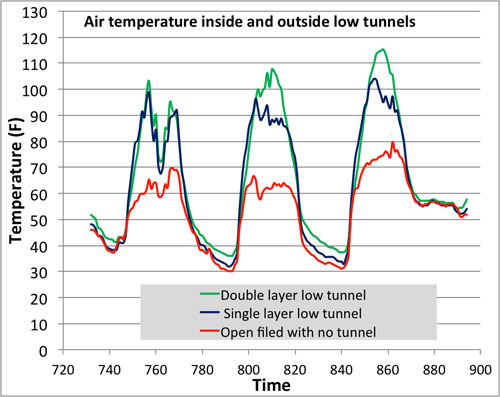Critical time for low tunnels management in vegetable production
Removing low tunnels and other row covers on time may help avoid heat injury and poor pollination.
Vegetable growers use row covers (low tunnels, floating row covers) routinely for frost protection, pest exclusion and earliness. Appropriate management of this production method is critical for optimum crop performance and profitability. Temperature management inside row covers is an important factor that requires constant monitoring of the crop and environmental conditions.
Plant monitoring
Routine monitoring allows growers to open or remove low tunnels when crops like tomatoes or peppers become too tall and the tunnels restrict their growth. Also, the growing point may be damaged by high temperatures if it touches row cover plastic.
Additionally, many vegetables, especially cucurbits, require insects for pollination. Low tunnels present both physical and biological barriers for many insects including bees. Even when the low tunnels are perforated, most insects normally stay outside because of the environmental conditions (temperature, relative humidity, light) that prevail inside the tunnels. It is, therefore, important to open low tunnels before flowers are open to facilitate pollination and enhance proper fruit set. A two- to three-day delay in low tunnel opening can cause significant yield reduction in some cucurbits. High temperatures also cause blossom abortion in tomatoes.
Weather monitoring
Monitoring weather conditions allows tunnels to be opened when temperatures become too high for specific crops. On hot and sunny days with calm winds, temperatures inside a clear, perforated polyethylene low tunnel can easily exceed 100°F even when ambient air temperature is only about 70°F (Figure 1). Just like freezing temperatures, extremely hot temperatures inside low tunnels can damage an entire crop. The tunnels have also been reported to funnel hot air uphill, especially in situations where the beds are formed following a slope.
Figure 1. Effect of low tunnels on air temperature at a commercial vegetable farm in Benton Harbor, Mich.

Management recommendations
With the risk of frost damage nearly over and high temperatures predicted for the upcoming Memorial Day weekend, it is time to open low tunnels to avoid crop injury and improve pollination. The low tunnels should be opened progressively to avoid “low tunnel removal shock.”
Most growers first make an opening of up to 6 inches on top of the tunnels a couple of days prior to their removal. Growers using spun-bond polypropylene row covers may want to use the materials for more than one crop. In that case, it is recommended to remove the covers during the coolest part of the day. After removal of low tunnels, crops like tomatoes and peppers should be staked immediately because they are fragile and susceptible to wind damage. Also for crops like tomatoes, it is critical to protect the leaves against bacterial and other diseases immediately after removal of the tunnels.
Dr. Ngouajio’s work is funded in part by MSU’s AgBioResearch.



 Print
Print Email
Email


